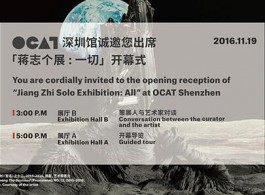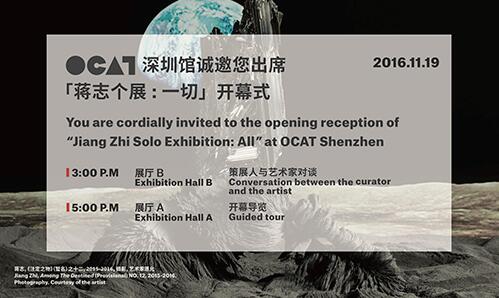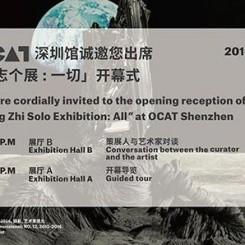From November 19th, 2016 to March 26th, 2017, OCAT Shenzhen will present “Jiang Zhi Solo Exhibition: All” in Exhibition Hall A. The exhibition is Jiang Zhi’s first museum solo show since 2012, which also marks his longanticipated return to Shenzhen. “Jiang Zhi Solo Exhibition: All” encompasses works from different stages of the artist’s career in the varied forms of painting, photography, video, sculpture, and installation. More than a simple chronicle of Jiang Zhi’s longstanding practice, “All” engages his work in a discussion of the construction of “wholeness.” “Light” is one of the most fundamental constituents that map a “holistic” world, the cornerstone of its visibility. Jiang Zhi has been concerned with light throughout his practice. He often skillfully employs photography and video, mediums that are often called “light writing”.
Signs of the light source also frequently appear in his work in varying forms, such as the neon light in the photographic work, Neon (2005); the flashlight in the installation, The God of the Small Things (2011); and the dark blue flame in the photography series, “Love Letters” (2011). In ancient times, the sun, the moon and other celestial bodies were the primary light sources, with the sun playing a crucial role in providing direct light, and the rise and fall of the sun and the moon testifying to the repetition of time. Modernism saw light as rational, neutral and transparent, an anatomical gaze. As uses of the artificial light further diversified (for entertainment, publicity, etc), varying sources of bright light began to refract and illuminate the urbanscape around the clock, breaking the temporal rhythm of day and night while blurring the boundary between personal space and public space in the meantime. Rather than the transparent gaze of modernism, the sources of “light” in Jiang Zhi’s work signify an “overexposure” of the personal domain in an information-driven world, where public space is gradually replaced by public images as mentioned by Paul Virilio. In the photography series, “Things Would Turn Simpler Once They Happened” (2006), human figures are irradiated by glaring lights, and personal traits and emotions dissipate under the regime of visibility. In the two series “Elegy” and “Flowers”, the powerful sensory experience of light is visualized as white lines. Like the glazing light that penetrates our personal space, these lines tow and pull the bodies and life-forms in suspense against a dark background, making visible their experience of pain.
Through “light,” Jiang manages to capture time in our field of vision. In “Love Letters,” several blazing flowers simultaneously wither and bloom in a quiet flame under the camera’s mechanical eye. In 2009, Jiang Zhi began working on a series of “glitch paintings,” “sketching” images of “system errors” from his computer screen. The complex colors and seemingly abstract lines on canvas are admittedly “realistic” depictions. The painting series “The word is yours, as well as ours” sees the translation of visual noise unreadable to computer systems to visible topographies on canvas that is subjected to the image history of painterly art. The video The Beginning of the Universe (2008) presents flaming fireworks on loop. By changing the speed and orientation of the fireworks through editing, Jiang conjures a spectacle of genesis where the cosmos is in utter chaos and probes the origin of a holistic world through Taoist philosophy. Through this work installed at the very back of the exhibition hall, Jiang Zhi’s investigation into wholeness arrives at consummation.
The illustrations in Gustave Doré’s Divina Commedia depict the highest realm of heaven, the Empyrean: a sea of angels join in a round dance in the sky, with their facial features blurred by the light of the glory of God, becoming part of the divine order. In the installation work, I’m Your Poetry NO.7: Itch of an Angel (2007), a set of “skins” of the two opposite sex constitute a symmetrical structure under the irradiation of light. Lust, an affect oftentimes expressed through skin, loses its zeal under the translucent silicone cover and is in turn overshadowed by a religious aura that works as a symmetry of veiling and unveiling—an effect also reflected in the exhibition design in which the artist also took part. In A Half (2007), objects cast shadows under a light, together composing the holistic body of a visible object through the reflection of a symmetric structure. But is that all which can be seen? In light of this question, the exhibition conjures up a survey of the artist’s creative outputs and, by construing the manifold significations of “light” and the concept of “visibility”, further reflects on what “all” that means.



